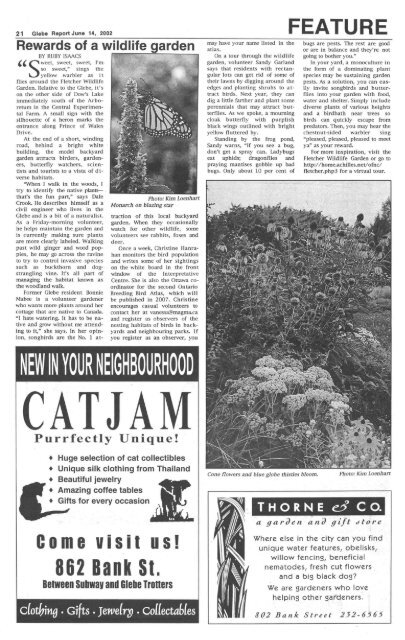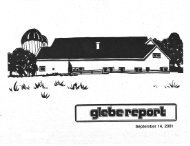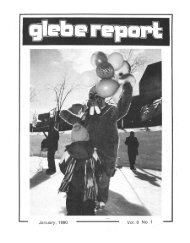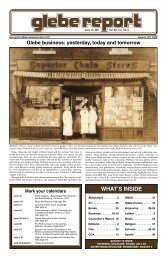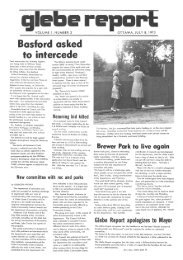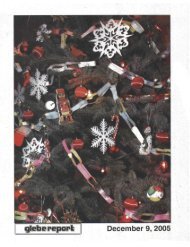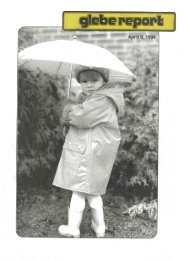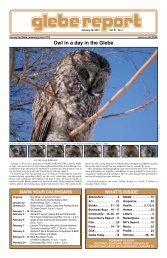Glebe Report - Volume 32 Number 6- June 14 2002
Glebe Report - Volume 32 Number 6- June 14 2002
Glebe Report - Volume 32 Number 6- June 14 2002
Create successful ePaper yourself
Turn your PDF publications into a flip-book with our unique Google optimized e-Paper software.
2 1 <strong>Glebe</strong> <strong>Report</strong> <strong>June</strong> <strong>14</strong>, <strong>2002</strong> FEATURE<br />
Rewards of a wildlife garden<br />
BY RUBY ISAACS<br />
weet, sweet, sweet, I'm<br />
so sweet," sings the<br />
yellow warbler as it<br />
flies around the Fletcher Wildlife<br />
Garden. Relative to the <strong>Glebe</strong>, it's<br />
on the other side of Dow's Lake<br />
immediately south of the Arboretum<br />
in the Central Experimental<br />
Farm. A small sign with the<br />
silhouette of a heron marks the<br />
entrance along Prince of Wales<br />
Drive.<br />
At the end of a short, winding<br />
road, behind a bright white<br />
building, the model backyard<br />
garden attracts birders, gardeners,<br />
butterfly watchers, scientists<br />
and tourists to a vista of diverse<br />
habitats.<br />
"When I walk in the woods, I<br />
try to identify the native plantsthat's<br />
the fun part," says Dale<br />
Crook. He describes himself as a<br />
civil engineer who lives in the<br />
<strong>Glebe</strong> and is a bit of a naturalist.<br />
As a Friday-morning volunteer,<br />
he helps maintain the garden and<br />
is currently making sure plants<br />
are more clearly labeled. Walking<br />
past wild ginger and wood poppies,<br />
he may go across the ravine<br />
to try to control invasive species<br />
such as buckthorn and dogstrangling<br />
vine. It's all part of<br />
managing the habitat known as<br />
the woodland walk.<br />
Former <strong>Glebe</strong> resident Bonnie<br />
Mabee is a volunteer gardener<br />
who wants more plants around her<br />
cottage that are native to Canada.<br />
"I hate watering. It has to be native<br />
and grow without me attend-<br />
ing to it," she says. In her opinion,<br />
songbirds are the No. 1 at-<br />
Photo: Kim Loenhart<br />
Monarch on blazing star<br />
traction of this local backyard<br />
garden. When they occasionally<br />
watch for other wildlife, some<br />
volunteers see rabbits, foxes and<br />
deer.<br />
Once a week, Christine Hanrahan<br />
monitors the bird population<br />
and writes some of her sightings<br />
on the white board in the front<br />
window of the Interpretative<br />
Centre. She is also the Ottawa coordinator<br />
for the second Ontario<br />
Breeding Bird Atlas, which will<br />
be published in 2007. Christine<br />
encourages casual volunteers to<br />
contact her at vanessa@magma.ca<br />
and register as observers of the<br />
nesting habitats of birds in backyards<br />
and neighbouring parks. If<br />
you register as an observer, you<br />
may have your name listed in the<br />
atlas.<br />
On a tour through the wildlife<br />
garden, volunteer Sandy Garland<br />
says that residents with rectangular<br />
lots can get rid of some of<br />
their lawns by digging around the<br />
edges and planting shrubs to attract<br />
birds. Next year, they can<br />
dig a little farther and plant some<br />
perennials that may attract butterflies.<br />
As we spoke, a mourning<br />
cloak butterfly with purplish<br />
black wings outlined with bright<br />
yellow fluttered by.<br />
Standing by the frog pond,<br />
Sandy warns, "If you see a bug,<br />
don't get a spray can. Ladybugs<br />
eat aphids; dragonflies and<br />
praying mantises gobble up bad<br />
bugs. Only about 10 per cent of<br />
bugs are pests. The rest are good<br />
or are in balance and they're not<br />
going to bother you."<br />
In your yard, a monoculture in<br />
the form of a dominating plant<br />
species may be sustaining garden<br />
pests. As a solution, you can easily<br />
invite songbirds and butterflies<br />
into your garden with food,<br />
water and shelter. Simply include<br />
diverse plants of various heights<br />
and a birdbath near trees so<br />
birds can quickly escape from<br />
predators. Then, you may hear the<br />
chestnut-sided warbler sing<br />
"pleased, pleased, pleased to meet<br />
ya" as your reward.<br />
For more inspiration, visit the<br />
Fletcher Wildlife Garden or go to<br />
http://home.achilles.net/ofncfletcher.php3<br />
for a virtual tour.<br />
NEW IN YOUR NEIGHBOURHOOD<br />
CATJAM<br />
Purrfectly Unique!<br />
IlLe<br />
Huge selection of cat collectibles<br />
Unique silk clothing from Thailand<br />
Beautiful jewelry<br />
Amazing coffee tables<br />
. Gifts for every occasion<br />
Come visit us!<br />
862 Bank St.<br />
Between Subway and <strong>Glebe</strong> Trotters<br />
cfoting . Gifts . jewefry . coffectabfes<br />
Cone flowers and blue globe thistles bloom.<br />
Photo: Kim Loenhart<br />
THORNE & CO.<br />
a garden and gift stare<br />
Where else in the city can you find<br />
unique water features, obelisks,<br />
willow fencing, beneficial<br />
nematodes, fresh cut flowers<br />
and a big black dog?<br />
We are gardeners who love<br />
helping other gardeners.<br />
802 Bank Street 252-6565


